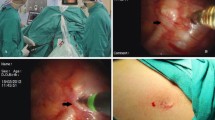Abstract
The objective of this study is to investigate the feasibility and safety of single-port microthoracoscopic thoracic sympathicotomy for the treatment of palmar hyperhidrosis. Between January 2008 and March 2013, 56 patients (36 male, 20 female; mean age 25.6 years, age range 16–39 years) underwent single-port microthoracoscopic thoracic sympathicotomy for palmar hyperhidrosis. Nineteen patients (33.9 %) had moderate palmar hyperhidrosis that could thoroughly wet a handkerchief, and 37 (66.1 %) had severe palmar hyperhidrosis with sweat dripping from the palm. Eight patients (14.3 %) had a positive family history, 34 (60.7 %) had plantar hyperhidrosis, 22 (39.3 %) had axillary hyperhidrosis, and 20 (35.7 %) had both plantar and axillary hyperhidrosis. In addition, 21 patients (37.5 %) had palmar pompholyx, five (8.9 %) had keratolysis exfoliativa, 10 (17.9 %) had chilblains, and nine (16.1 %) had palmar rhagades. A single 10-mm skin incision was made in the third intercostal space at the anterior axillary line, posterior to the pectoralis muscle. A 5-mm microthoracoscope and a 3-mm microelectrocautery hook were inserted through a single port into the thoracic cavity. The third and fourth ribs were identified, and the sympathetic chain was cut using the microelectrocautery hook. The bypassing nerve fibers, such as the Kuntz nerve fiber bundle, were ablated for 2–3 cm along the surface of the rib. The palmar temperature was recorded before and after sympathicotomy. All 56 procedures were completed using single-port microthoracoscopy. No postoperative complications such as hemorrhage, wound infection, hemopneumothorax, bradycardia, or Horner’s syndrome were observed. Bilateral procedures were completed in 20–56 min (mean 30 min). The palmar temperature increased by 2.2 ± 0.3 °C after surgery. The postoperative hospital stay was 1–4 days (mean 2.5 days). Mild compensatory sweating of the back and thigh occurred in five patients (8.9 %) at 2–3 days after surgery and disappeared at 7–15 days. The patients were followed up for 28.5 months (range 1–62 months). Hyperhidrosis resolved in both hands after surgery, and the previously wet, cold hands became dry and warm. The efficacy rate was 100 %. Plantar hyperhidrosis was also significantly reduced in 33 of the 34 patients with this condition (remission rate 97.1 %), and axillary hyperhidrosis was significantly reduced in 19 of 22 patients (remission rate 86.4 %). Eighteen of the 20 patients (90.0 %) with both plantar and axillary hyperhidrosis experienced significant alleviation of their symptoms. Single-port microthoracoscopic thoracic sympathicotomy is a safe, convenient, and effective method of treating palmar hyperhidrosis. This procedure can accurately locate the sympathetic chain with a small incision, minimal invasiveness, and good cosmetic results. The procedure is suitable for extensive clinical use.


Similar content being viewed by others
References
Strutton DR, Kowalski JW, Glaser DA, Stang PE (2004) US prevalence of hyperhidrosis and impact on individuals with axillary hyperhidrosis: results from a national survey. J Am Acad Dermatol 51(2):241–248
Tu YR, Li X, Lin M, Lai FC, Li YP, Chen JF, Ye JG (2007) Epidemiological survey of primary palmar hyperhidrosis in adolescent in Fuzhou of People’s Republic of China. Eur J Cardiothorac Surg 31(4):737–739
Moreno Balsalobre R, Moreno Mata N, Ramos Izquierdo R, Aragón Valverde FJ, Molins López-Rodo L, de Andrés JJ R, García Fernández JL, Cañizares Carretero MÁ, Congregado Loscertales M, Carbajo Carbajo M (2011) SEPAR. Guidelines on surgery of the thoracic sympathetic nervous system. Arch Bronconeumol 47(2):94–102
Cerfolio RJ, De Campos JR, Bryant AS, Connery CP, Miller DL, DeCamp MM, McKenna RJ, Krasna MJ (2011) The Society of Thoracic Surgeons expert consensus for the surgical treatment of hyperhidrosis. Ann Thorac Surg 91(5):1642–1648
Lai YT, Yang LH, Chio CC, Chen HH (1997) Complications in patients with palmar hyperhidrosis treated with transthoracic endoscopic sympathicotomy. Neurosurgery 41(1):110–113
Lin JZ, Zhou Y (2007) Thoracoscopic sympathicotomy surgery. Zhonghua Wai Ke Za Zhi 45(14):941–944
Li X, Tu YR, Lin M, Lai FC, Chen JF, Miao HW (2009) Minimizing endoscopic thoracic sympathicotomy for primary palmar hyperhidrosis: guided by palmar skin temperature and laser Doppler blood flow. Ann Thorac Surg 87(2):427–431
Licht PB, Pilegaard HK (2004) Severity of compensatory sweating after thoracoscopic sympathicotomy. Ann Thorac Surg 78(2):427–431
Yanagihara TK, Ibrahimiye A, Harris C, Hirsch J, Gorenstein LA (2010) Analysis of clamping versus cutting of T3 sympathetic nerve for severe palmar hyperhidrosis. J Thorac Cardiovasc Surg 140(5):984–989
Reisfeld R (2006) Sympathicotomy for hyperhidrosis: should we place the clamps at T2-T3 or T3-T4? Clin Auton Res 16(6):384–389
Ramsaroop L, Singh B, Moodley J, Partab P, Pather N, Satyapal KS (2003) A thoracoscopic view of the nerve of Kuntz. Surg Endosc 17(9):1498
Licht PB, Pilegaard HK (2006) Gustatory side effects after thoracoscopic sympathicotomy. Ann Thorac Surg 81(3):1043–1047
Yazbek G, Wolosker N, de Campos JR, Kauffman P, Ishy A, Puech-Leão P (2005) Palmar hyperhidrosis—which is the best level of denervation using video-assisted thoracoscopic sympathicotomy: T2 or T3 ganglion? J Vasc Surg 42(2):281–285
Yoon SH, Rim DC (2003) The selective T3 sympathicotomy in patients with essential palmar hyperhidrosis. Acta Neurochir (Wien) 145(6):467–471
Neumayer C, Zacherl J, Holak G, Jakesz R, Bischof G (2003) Experience with limited endoscopic thoracic sympathetic block for hyperhidrosis and facial blushing. Clin Auton Res 13(1):I52–I57
Yang J, Tan JJ, Ye GL, Gu WQ, Wang J, Liu YG (2007) T3/T4 thoracic sympathictomy and compensatory sweating in treatment of palmar hyperhidrosis. Chin Med J (Engl) 120(18):1574–1577
Ahn SS, Wieslander CK, Ro KM (2000) Current developments in thoracoscopic sympathicotomy. Ann Vasc Surg 14(4):415–420
Doolabh N, Horswell S, Williams M, Huber L, Prince S, Meyer DM (2004) Mack MJ thoracoscopic sympathicotomy for hyperhidrosis: indications and results. Ann Thorac Surg 77(2):410–414
Conflict of Interest
The authors report no conflicts of interest.
Author information
Authors and Affiliations
Corresponding author
Rights and permissions
About this article
Cite this article
Shi, H., Shu, Y., Shi, W. et al. Single-Port Microthoracoscopic Sympathicotomy for the Treatment of Primary Palmar Hyperhidrosis: an Analysis of 56 Consecutive Cases. Indian J Surg 77, 270–275 (2015). https://doi.org/10.1007/s12262-015-1288-6
Received:
Accepted:
Published:
Issue Date:
DOI: https://doi.org/10.1007/s12262-015-1288-6




